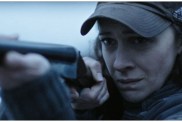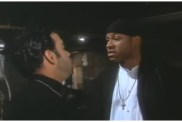Sometime over the last seven or eight months, there’s a good chance you’ve probably heard the odd title of Ari Folman’s animated documentary Waltz with Bashir and wondered what the movie was about.
Like last year’s Persepolis, Folman’s animated movie played very well on the film festival circuit going back to its premiere at the Cannes Film Festival in May. It’s won a number of awards and was made Israel’s selection for this year’s Foreign Language Oscars. Also like Persepolis, Folman’s film is autobiographical, though the material is handled more like Brett Morgen’s Chicago 10 in that it’s an animated documentary.
Five years ago, Folman sought out some of his fellow soldiers to find out exactly what happened while they were fighting together during the Lebanon War in the early ’80s, a period of his life that he had completely blocked out in his memory despite a number of haunting images that kept reappearing in dreams. The movie isn’t a history lesson as much as a personal look at one man’s war experiences using imaginative animation to embellish the soldier’s stories with evocative dream sequences. Without having studied the Lebanon War, it’s sometimes hard to figure out exactly where the movie is going, but the ending is probably one of the most shocking things you’re likely to experience this year, and it’s one of the things that makes the film so powerful and memorable.
ComingSoon.net sat down with Folman after the New York Film Festival press conference for Bashir back in October.
ComingSoon.net: I don’t want to give everything away but I just want to say that having seen the movie a second time, that ending still hits you in the gut even knowing that it’s coming, which is surprising. So what originally got you started on the road to making this movie?
Ari Folman: Five years ago, I turned 40 and I wanted a release from the reserve army where I didn’t do a lot. I was just a silly screenwriter there, writing the instructional shorts for TV, “How to Defend Yourself in an Atomic Attack,” stuff like that. I wanted an early release because usually you’re released when you’re 45 and I said, “Okay, you know what? We’re having this experiment now so if you want a release, you can go to the army’s therapist and go for three meetings. All you have to do is tell them everything you went through in the army and then you’re out.” So I went for eight or ten session and when I was out, I was not surprised by the stories I told because they didn’t seem to me to be very extreme, but I was shocked for me that it was the first time to tell these stories. I was deeply repressed. I worked pretty hard to not deal with those stories, and then I went out and I met those people, first circle of friends and family and I realized it’s a common problem. People don’t talk about their past in the army, and this is when I decided to deal with: memory. So for me, it was basically not a film about the massacre, it was a film about memory. You were in the press conference? I don’t want to repeat things. But then I advertised on the internet and then we heard the stories and then I wrote the screenplay and then everything I told in the press conference about how we did the film I won’t repeat.
Since you weren’t at that press conference, here is what Folman said about the process of animating the film:
“This film was always meant to be an animated film. I never thought even that there is a chance to do it in any other way. Not as a fiction film, definitely not as a classic documentary film, and when I imagined the film in my mind before I was writing it, it was always with drawn characters. If you look at all the elements you have in the film – memory, lost memory, dreams, subconscious, hallucinations, drugs, youth, lost youth – I think for me the only way to combine all those things in one storyline was drawings and animation. As a filmmaker, I just felt totally free.”
“What we did basically, the process is that I advertised on the internet looking for stories from the first Lebanon War, and then we had a very long research (period)more than one hundred people called. I felt they were in many ways waiting for someone to come and hear their stories. Then I wrote a feature-length screenplay, 90 pages, mostly based on my personal story, not on all the research that we had. Then I realized there is no way that the human ear would be tolerant towards location, sound and animation, so we shot everything in a sound studio, the whole thing. All the interviews and everything we could dramatize in the sound studio, and we edited everything into a feature-length film with some sketches in between. This was the main reference for the film. We didn’t do rotoscope animation, meaning that we didn’t draw over the video, but drew the video from scratch. The video and the sound was just a reference. First we did storyboards out of the video and then we moved the storyboards with very basic movement. We screened it on the big screen to make sure the drama was working, then we took the key frames of the film, more than 3,000, and we started animating. It took about four years.”

CS: You said that you wrote a full screenplay and script, then you got the people who originally told you the stories to perform the script? I got the impression you recorded some of the original interviews and used that audio.
Folman: The script was written according to the research and the interviews. The research I did and some of them I repeated again, and the script was based upon predicted answers I would get from my interviews that I already heard. Some of them told the stories just the same, like this journalist told the story a hundred times so he told it again. Some of them told it better, some of them told it worse, it depends. The script was based on previous meetings I had with the people.
CS: You mentioned being in the military five years ago. Is that very common to be in the army that late in life?
Folman: Reserve army is something everybody does, but it depends what you do. It’s between two weeks and a month every year, and I didn’t do it after. I was called once a year to write a one-minute instructional vignette, that’s it.
CS: I didn’t realize they had reservists called in to make films. I think you mentioned earlier that you also came up with the music for the movie before creating the visuals which is not done very often, and I was curious why you did that?
Folman: The music? It was just a matter of timing. As I told you, I finished writing and I made contact with this guy, Max Richter, an incredible musician. I flew over to Edinburgh and we started working and he was pretty fast. He made the first sketches on his computer pretty fast. He made them and then we started working on the animation, so we had it, but then in the end, it took him some time to bring the band over from London and record all the real instruments, but we had the music early and I insisted on having it early because I wanted the animators to be influenced by the music. I put a lot of effort into the music and it’s very important to me, soundtracks, and I think it’s wrong to do it just at the last minute, the last stage, I don’t know why. Why can’t it be done with everything else?
CS: I know a few directors who have their composers involved in the preproduction stage before they even shoot.
Folman: With me, everybody is involved from the very beginning. The editor is involved in the screenwriting. She reads it, she knows, the sound editor, the sound designer, everybody’s there.
CS: What’s Max Richter’s background before working on your movie?
Folman: He’s doing a lot of electronic stuff in combination with classical, because he has a classical education on the piano. He’s kind of an indie British composer, but he’s in the extreme. He’s not like Radiohead.
CS: I also wanted to ask about the rock songs you used because you mentioned the soundtrack being important, since you mixed Max’s score with some Israeli rock tunes?
Folman: One song was written especially for the film, the “Good Morning Lebanon” song. The other song was a remake from an American band called Cake and they have “Korea” so the really hard rock ‘n’ roll song “Bomb Beirut” was basically the “Korea” song by Cake.
CS: How hard was it getting financing to do this project?
Folman: Very hard. It was the most complicated thing in the project. I found $80,000 from a TV station. I made a three-minute scene and traveled to the Hot Docs in Toronto, I pitched it, I got out of France, ITVS. I had more money, I came home and we made another twenty minutes, and I took the twenty minutes and traveled back to France and to Germany, brought more money from Europe, got more home from the funds, and it was like the “Salami Process,” we call it.
CS: This is a very personal project so when you were trying to sell it to these other people, were they just interested in the story of the massacre or the ideas about suppressed memories? What was the big selling point that got people involved?
Folman: The problem was clearing the film as an animated documentary. This was the main problem, because people sit in documentary funds, they get 10 times less money than people in fiction, and then they have to spend the money, and they think, “Should I spend it on animation? Is animation a documentary? Is it real? Will people believe the story? Is it true?” They gave me a hard time. It was too risky for them, and today, I don’t give a damn. If I would do it now, I would declare it as a fiction film, animated, and this is it. Raise the money, work…

CS: Are you an artist yourself, do you draw?
Folman: No.
CS: Did you get any paintings or visual references before you started animating?
Folman: Graphic novels. I worked with the team before on a previous documentary. I knew them, I knew the artists, I knew what their capabilities are, and I knew what I was going to do anyhow.
CS: Did you present the script to them and have them do some paintings as visual ideas to show to people?
Folman: No, I remember first meeting with the illustrators in my studio. There were four of them and each one had a paper block, and a pen, and they were (imitates sketching) drawing…” Do you like this?” “No.” That was it.
CS: A lot of these artists, did they have a very specific style or did you have something in mind that you wanted to use for the look of the movie? Was it just starting from scratch?
Folman: Everything was from scratch. I think with artists, you can’t adopt them. You can’t tell them, “I want you to draw like this guy.” I see all those Chris Ware graphic novels, “Draw like Chris Ware.” It won’t work. You have to choose the right guy that would do good with this kind of film, but you can’t tell them how to draw, it’ll never work.
CS: Was there one specific artist who designed the initial look of the film’s visuals?
Folman: Yeah, David Polonsky, definitely. Actually, he drew 80% of the film alone, and then there’s this guy who lives here, Tomer (Hanuka), who drew some of the dream sequences. His twin brother (Asaf Hanuka) did a lot of work, the tank scenes and everything. There were four of them.
CS: One thing that’s interesting is that you didn’t try to make this movie a history lesson by giving any background about Lebanon War, and I was wondering about that decision of just letting this story unfold without sharing that information?
Folman: I think it makes the film more universal. We were even discussing in France when we completed the film to put a title in the end saying how many people were killed, facts, and I decided not to go for it. It makes it more universal, and also explaining the complexities of how many different armies and parties were there during the ’80s, it’s just impossible. It’s so complicated. We tried to mark a little bit like the Christians, we see a lot of crosses, and a lot of images of Bashir. We did it really graphically. We tried to mark things in a graphic way.
CS: Did you want people to look into what happened themselves and do their own research rather than telling them everything?
Folman: Yes, hopefully you’d go home, you’d “Google the Sabra and Shatila Massacre” and you would learn.
CS: As a director who’s done stuff non-animated before, I was curious about how you made the transition to working with animators, because you’re kind of at their mercy where you have to explain to them what you want and put a lot of trust in them. Do you feel you have to work harder to get the results?
Folman: It is. There is a lack of cinematic way of capturing things, but they’re so brilliant, this crew was, that it was easy to explain what I wanted. Once the drawings started moving in animation, this was my job, to make it cinematic, to make this shot longer and this track shot, change the position, this was my role as a director.
CS: Did you end up cutting a lot of things out of the final movie to shorten it or was it very close to the original script?
Folman: I dropped an eleven minute scene that was nearly done once before the premiere. It was a great scene but it didn’t fit in the script where it was located and there was no way I could cut it to make it shorter.
CS: One thing that’s interesting is that Israel picked your movie for their Oscar choice, though you’d think that they wouldn’t want to support a film that shows a portion of Israel’s history that’s not partiularly favorable.
Folman: It’s not Israel, it’s not the government. There is a Film Academy of 700 people, all of them working in the film industry, actors, actresses, gaffers, they vote, they picked it.

CS: So there’s nothing about the politics of the movie that affects that choice?
Folman: They don’t give a damn. They vote for the best movie.
CS: How has the movie been received over there?
Folman: In Israel, it’s been received great. Great reviews and a very warm welcome. I was surprised, it was easy, there was no political debate whatsoever around the film. It was great.
CS: It hasn’t been shown in Lebanon at all?
Folman: There was a couple French-Lebanese journalists who wanted to take it with them to Lebanon, just screeners, spread it around. We didn’t do that but we might do that now.
CS: I’d think it would be beneficial to them to have this portion of history remembered.
Folman: I think Christians in Lebanon are still embarrassed about what happened. I know that Bashir Gemayel’s nephew was in the premiere in Paris, which was a great premiere, and he talked to me after the screening. He looks pretty much like all the Gemayel family, good looking man, and he thought that the film was just about telling the whole story, except for small details that were wrong, but then he thought that I should have brought the other side of the Phalangist regime which was, for him, how cultural they were. They could quote Beaudilaire and French poetry and everything.
CS: Do you have any inclinations to do more of this kind of work?
Folman: Yeah, I’m going to my next film, it’s going to be animated as well, most of it. I optioned a Stanislav Lem novel called “The Futurological Congress.” one of my favorites. It’s an amazing book. Hopefully I’m going to do that in Europe. It’s totally fiction this time with an actress going to lead it. What we did with going backwards to the past, we’re going to do with the future this time.
Waltz with Bashir opens in New York and L.A. on Thursday, Christmas Day. (For more information about the story and the process of making the film, you can download the colorful official press kit, which actually makes the film an easier to comprehend experience.)









